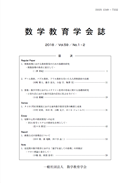All issues

Volume 49 (2008)
- Issue 3-4 Pages 1-
- Issue 1-2 Pages 1-
Volume 49, Issue 3-4
Japan Journal of Mathematics Education and Related Fields
Displaying 1-7 of 7 articles from this issue
- |<
- <
- 1
- >
- >|
-
An attempt which teaches probability for schoolchildrenYasuyuki Okabe2008Volume 49Issue 3-4 Pages 1-7
Published: 2008
Released on J-STAGE: April 21, 2020
JOURNAL FREE ACCESSIn this study, in recognition of a probability concept, while considering this structure, educational contents and the method for promoting the rise of a level are developed, and it aims at constituting a curriculum. In this report, I developed the teaching materials for schoolchildren. And, I report on the result of the experiment that uses it. It was shown that this learning promoted the rise of a level in conclusion.View full abstractDownload PDF (947K) -
Striving for education that will develop people who can lead the way in our societyAkira Yanagimoto2008Volume 49Issue 3-4 Pages 9-16
Published: 2008
Released on J-STAGE: April 21, 2020
JOURNAL FREE ACCESSMathematical modeling appeared in the 1980's during the historical trend when students were encouraged to study mathematics on their initiative. Since then, educational practice of mathematical modeling has been developed multifariously, and has made progress in Japan. Today, the diversification of learners and the need to raise their ability both individually and as a group are increasing even more than before. On the other hand, confusion has begun over "Mathematical Activity" (a new junior high school course of study). In this situation, it can be said that we are at a phase where research and practice of mathematical modeling must also search for a new direction. Considering the above mentioned issues, the authors in this paper look back earnestly on the mathematical modeling research and practice up to now, illustratively show their current state and limits, and conclude by proposing a new direction in mathematical modeling research and practice.View full abstractDownload PDF (954K) -
Noboru Saito, Miyo Akita2008Volume 49Issue 3-4 Pages 17-26
Published: 2008
Released on J-STAGE: April 21, 2020
JOURNAL FREE ACCESSIn this paper, we showed clearly how the teachers of elementary schools understood structural relations between the learning elements of a teaching unit in arithmetic. We made 95 teachers draw concept maps of unit "Ratio" of arithmetic grade 5 and unit "Multiplication and Division of Fraction" of arithmetic grade 6 in six elementary schools and analyzed the concept maps with a transfer coefficient. As a result, the following matters became clear.
(1) For the analysis of recognition of the teaching materials structure, a method with a transfer coefficient by using concept map is effective, and the value of transfer coefficient may be effective to explain a style of the recognition structure.
(2) The recognition of the understanding teaching materials structure of teachers is very low because 96% of teachers seldom understand the structural relations of the teaching contents.
(3) Even if the teaching profession years of experience of teachers increase, the understanding of structural relations is same and the recognition of teaching materials structure of teachers is not improved.
(4) The recognition of teaching materials structure of teachers tends to become weak as a time progresses.View full abstractDownload PDF (1080K) -
Tetsuya Kobayashi, Masami Isoda2008Volume 49Issue 3-4 Pages 27-37
Published: 2008
Released on J-STAGE: April 21, 2020
JOURNAL FREE ACCESSThe survey aims to know how analytical thinking is taught at high school classrooms. Depending on 102 teachers' responses on the survey for all high schools in Ibaraki prefecture, the results are followings. Firstly, less than half teachers teach the analytical reasoning through the typical problem on the survey. Secondly, the ratio of teachers who did not write the reasoning for students' understanding of the problem solution is larger in the case of experienced or higher achievers' schools teachers. The ratio of the teachers who do not teach analytical reasoning on the problem was improved through the survey.View full abstractDownload PDF (1457K) -
Sadao Tachibana2008Volume 49Issue 3-4 Pages 39-48
Published: 2008
Released on J-STAGE: April 21, 2020
JOURNAL FREE ACCESSIn this paper we will descrive the system of teacher education of Finland. It is said that one of the reasons behind Finnish students' success in the PISA would be a high quality of school teachers. We Japanese have to know and learn the Finnish teacher education. Then we will get some suggestions from it. It is expected to have a good reflectoion to the Japanese education of mathematics and science. We will also descrive the general education system of Finland and the actual students' teaching practice in the teacher training school of Turku University.View full abstractDownload PDF (1799K) -
Masami Isoda, Masataka Seki2008Volume 49Issue 3-4 Pages 49-59
Published: 2008
Released on J-STAGE: April 21, 2020
JOURNAL FREE ACCESSThis research aimed to develop the subject matter to teach the idea of fundamental theorem on calculus for under achieved students. The idea of fundamental theorem is defined by the change of changes (differentiation) and the summation of changes (integration). The research surveyed the understanding of under achieved students, developed the teaching with the subject matters and tools, and evaluated the effect of teaching from their achievements.View full abstractDownload PDF (1930K) -
You must not forget (1+√5)/2 is also another golden ratioShuntaro Sato2008Volume 49Issue 3-4 Pages 61-64
Published: 2008
Released on J-STAGE: April 21, 2020
JOURNAL FREE ACCESSWe have famous golden ratio in the history of mathematics. But what is the value of golden ratio? We have six kinds of textbook in Japan. The author was astonished by the different two kinds of value of golden ratio. That is to say, one textbook states the golden ratio is (-1+√5)/2, the other five textbooks state (1 +√5)/2. The author asserts that the golden ratio is “(-1 +√5)/2 or (1+√5)/2.”View full abstractDownload PDF (287K)
- |<
- <
- 1
- >
- >|